How to Make Sourdough Bread From a Starter
| Modified: by | | This website earns income from ads, affiliates, and sponsorships.



A simple, no-knead sourdough bread recipe that's easy to make using your sourdough starter.
Are you looking for an everyday sourdough bread recipe that's easy and not overly complicated? Well, look no further. We've put together a delicious and simple sourdough bread recipe that you can make overnight, with minimal effort.
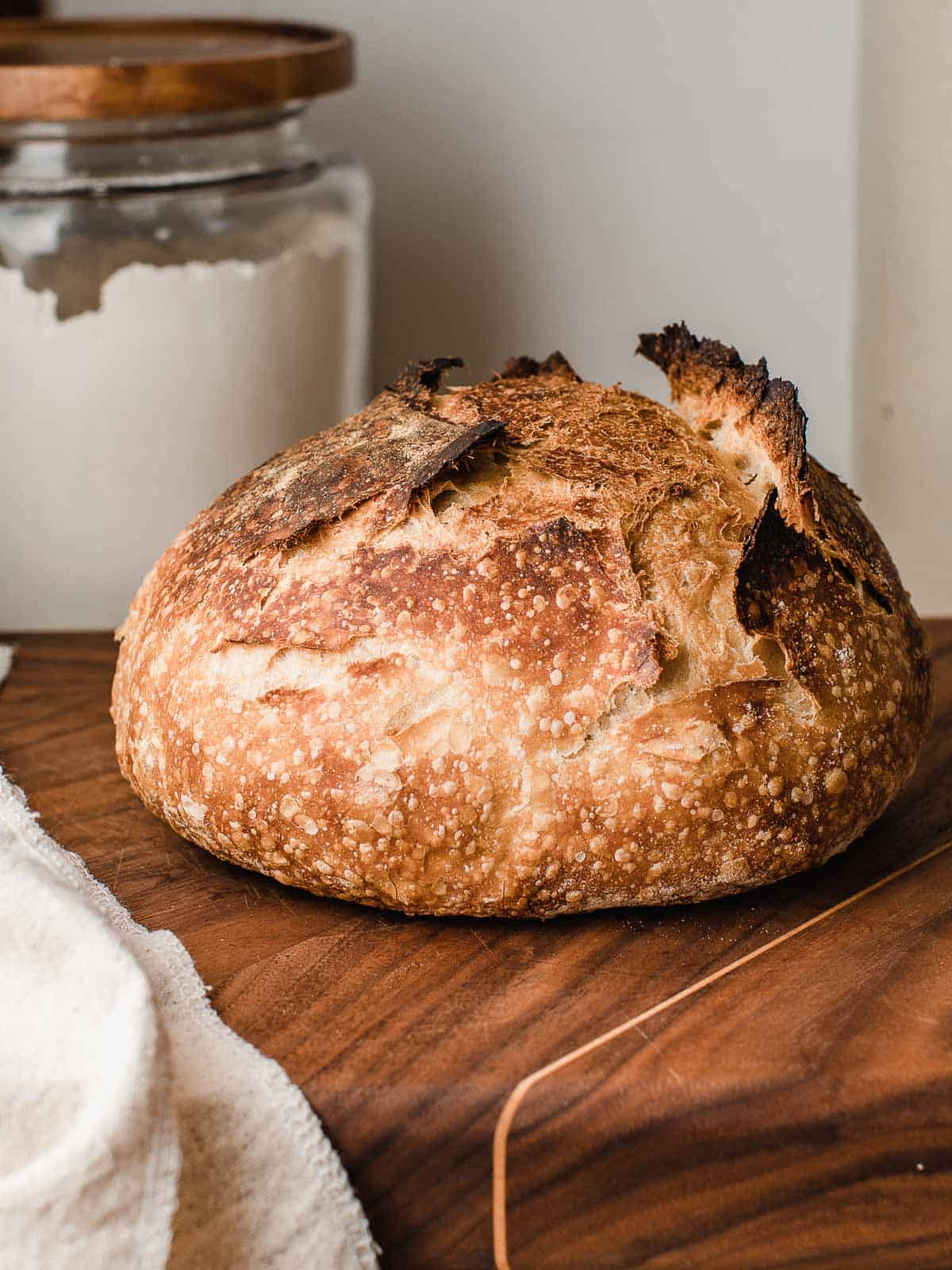
We will guide you step-by-step, through the entire process so that you can begin baking your very own, homemade sourdough bread.
With this recipe, you'll get a feel for how to bake a basic loaf of sourdough bread before you move on to more advanced techniques like the ones used in our sourdough country loaf bread. This is truly a beginners sourdough bread recipe!
Give the dough an overnight rise for an early morning bake or mix it in the morning for freshly baked sourdough bread with dinner. This recipe is easily adjusted to fit your schedule!
Jump to:
- What is sourdough bread?
- How to make it
- Sample baking schedule
- How to store and freeze
- Tips for success
- Common questions
- Recommended equipment
- More easy sourdough bread recipes
- Beginners Sourdough Bread Recipe
What is sourdough bread?
Sourdough bread is naturally leavened bread made without commercial yeast. The wild yeast in a sourdough starter is what makes the bread rise. The only ingredients needed to make sourdough bread are water, flour and salt.
A sourdough starter is made by mixing flour and water together in a jar. Wild yeast from the surrounding environment feeds off of the flour, causing the number of yeast to multiply within the mixture. With regular feedings, the starter becomes stronger and stronger and can eventually be used to bake sourdough bread.
The process of building a new sourdough starter from scratch takes anywhere from 7-14 days and the number of days it requires will depend on variables such as temperature and flour. But, once you've developed a mature and healthy starter, maintaining it is easy!
Plan on baking several loaves before the process really start to make sense. You may make a few mistakes along the way while you learn, but try not to be hard on yourself. Even if a loaf doesn't turn out perfectly, you can still use it to make things like homemade croutons or cheesy garlic bread.
If you really want to treat yourself, make sure to read our tutorial for homemade butter and cultured butter. Nothing beats fresh butter on warm sourdough bread!
How to make it
Before we dive into the details, let's take a look at the 6 basic steps you will take to prepare a basic loaf of sourdough bread.
- Feed your sourdough starter let rise until doubled.
- Mix the dough and let it rest for 1 hour.
- Perform 2 sets of stretch and folds 30 minutes apart.
- Cover the bowl and let the dough ferment for 7-10 hours on your kitchen counter.
- Shape the dough and let it rise for 1 hour.
- Bake.
Step one: feed the sourdough starter
To a clean jar add 10 g starter + 25 g water + 25 g flour and let rise until doubled. This small ratio of starter to flour/water should take anywhere from 8-12 hours to double.
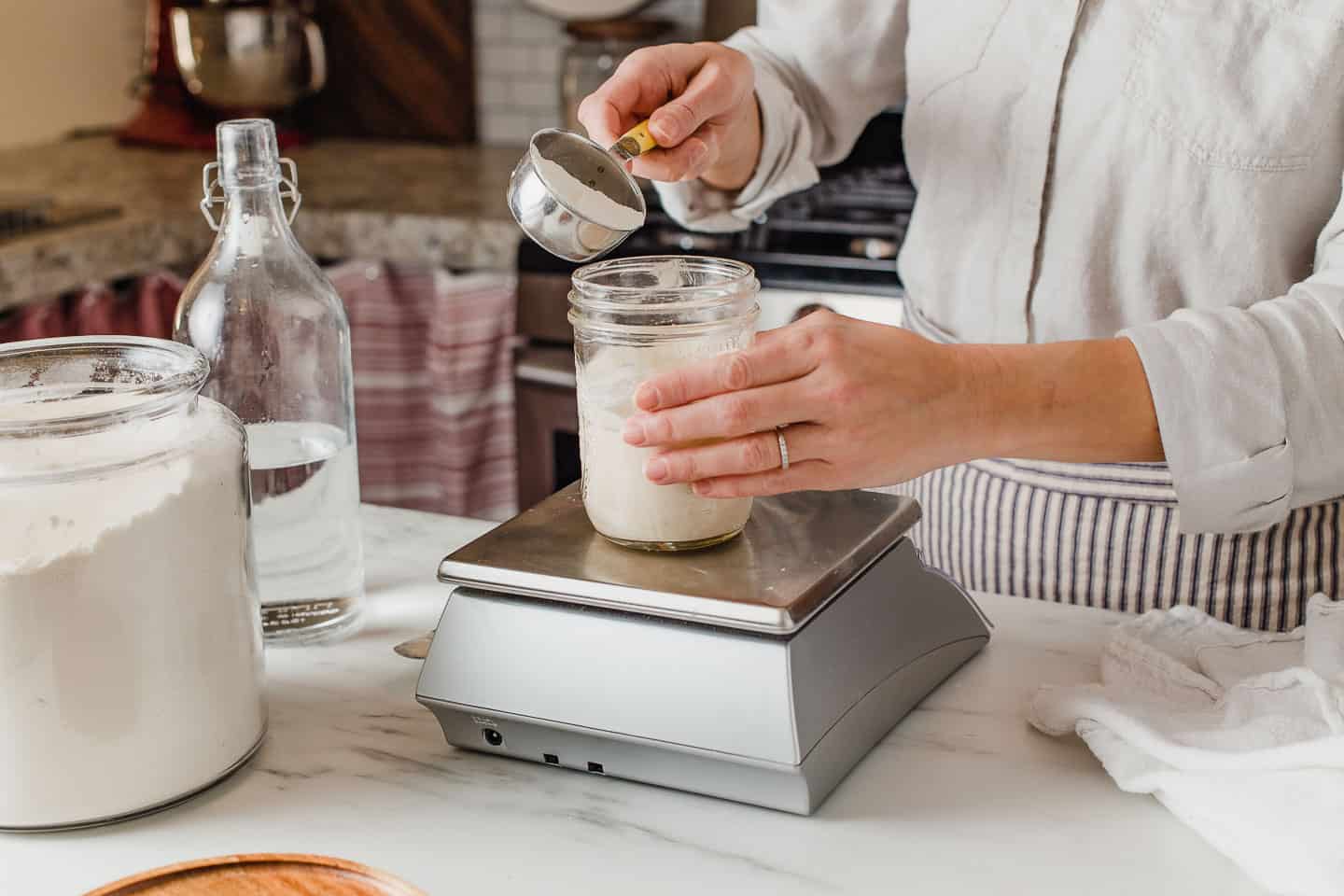
Step two: mix the dough
Transfer the 50g of active starter and 350g water into a large mixing bowl. Stir to distribute the starter evenly. Add 500g bread flour and 10g sea salt to the bowl and use a stiff spatula or your hands to work the ingredients together until it forms a shaggy mass, making sure that there are no dry bits of flour. Cover the bowl and let the dough rest for 1 hour.
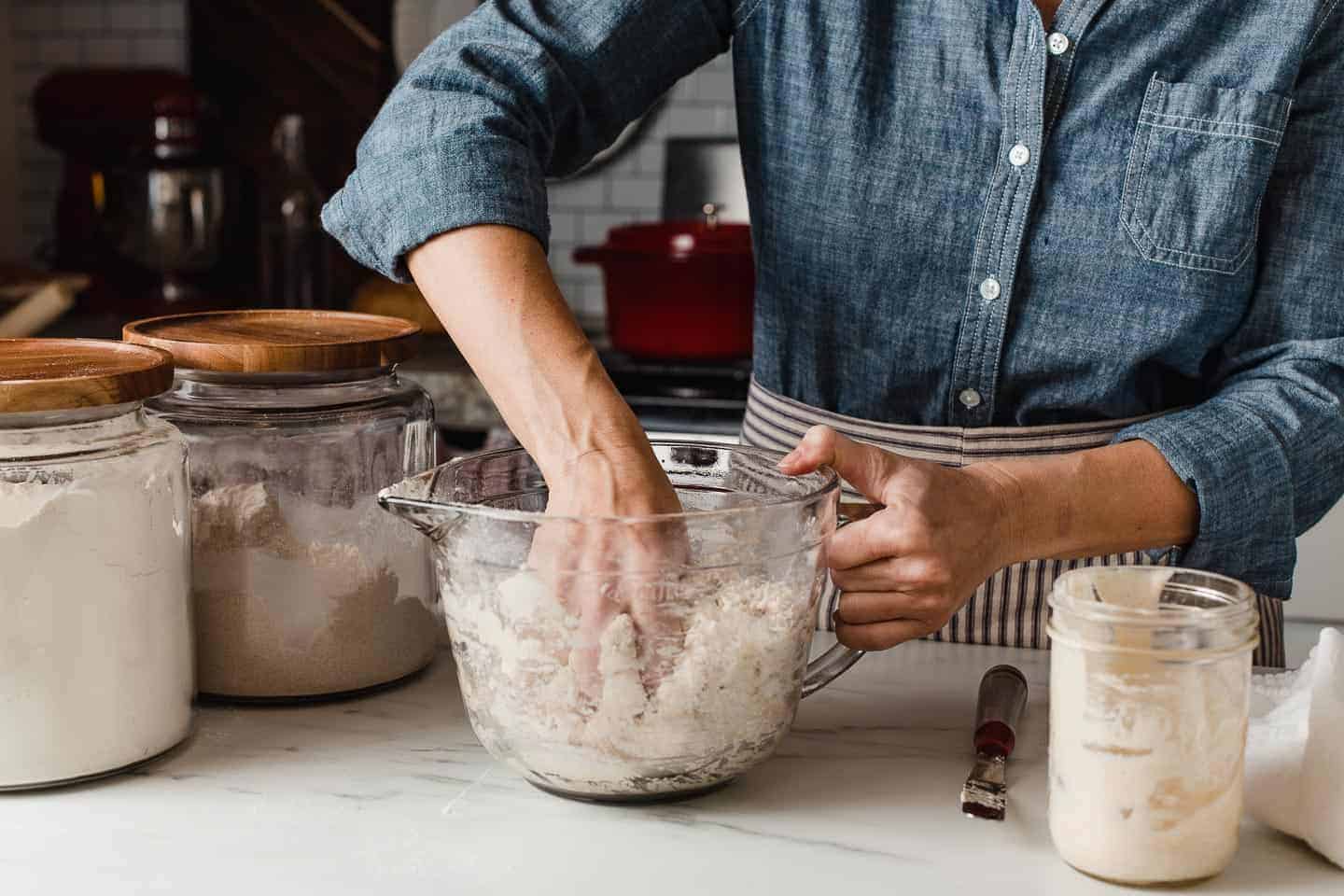
Step three: stretch and fold the dough
Wet your hand with water to prevent sticking. Pick up the dough on one side and stretch it up and over itself. Turn the bowl a quarter turn and repeat this step until you have turned the bowl a full circle. The dough should form into a tight ball. Let the dough rest 30 minutes and repeat the stretch and fold process.
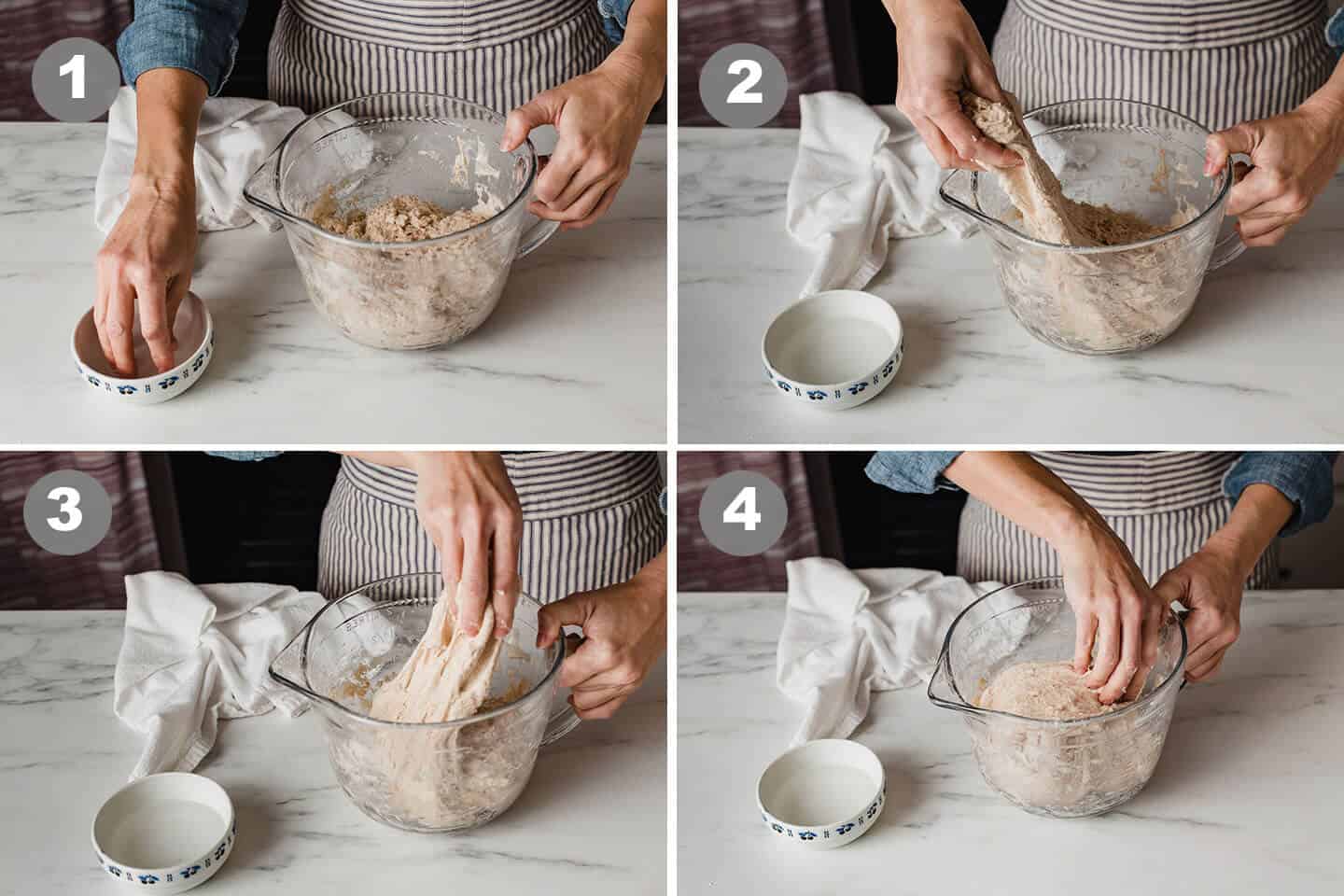
Step four: bulk fermentation
After the second set of stretch and folds, cover the bowl and let the dough ferment for 7-10 hours on your kitchen counter. The dough should rise by about 50% when it's ready for the next step.

Step five: shape and second rise
Turn the dough out onto a lightly floured surface. Shape the dough into a ball by pulling 4 sides of the dough into the middle of itself.

Turn the dough seam-side down and gently cup the dough, pulling and twisting until it forms a tight skin on the outside.
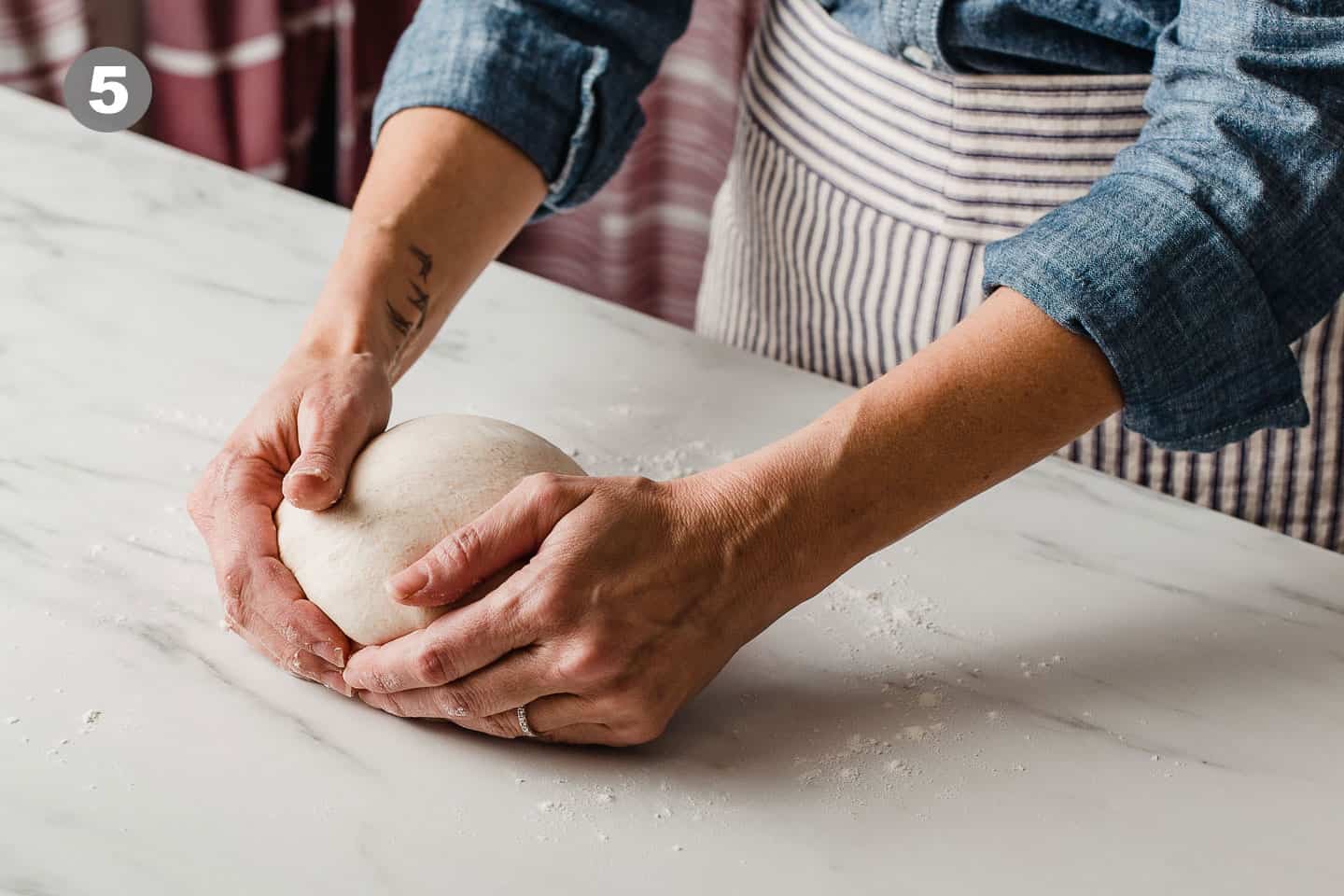
Center the dough onto a piece of parchment paper, seam-side down. Use the parchment as a sling to lift the dough into a bowl. Cover the bowl with a tea towel and let the dough rise for 30 minutes to 1 hour. (The dough is ready when an indentation made with your thumb springs back slowly. See our troubleshooting guide for details.)
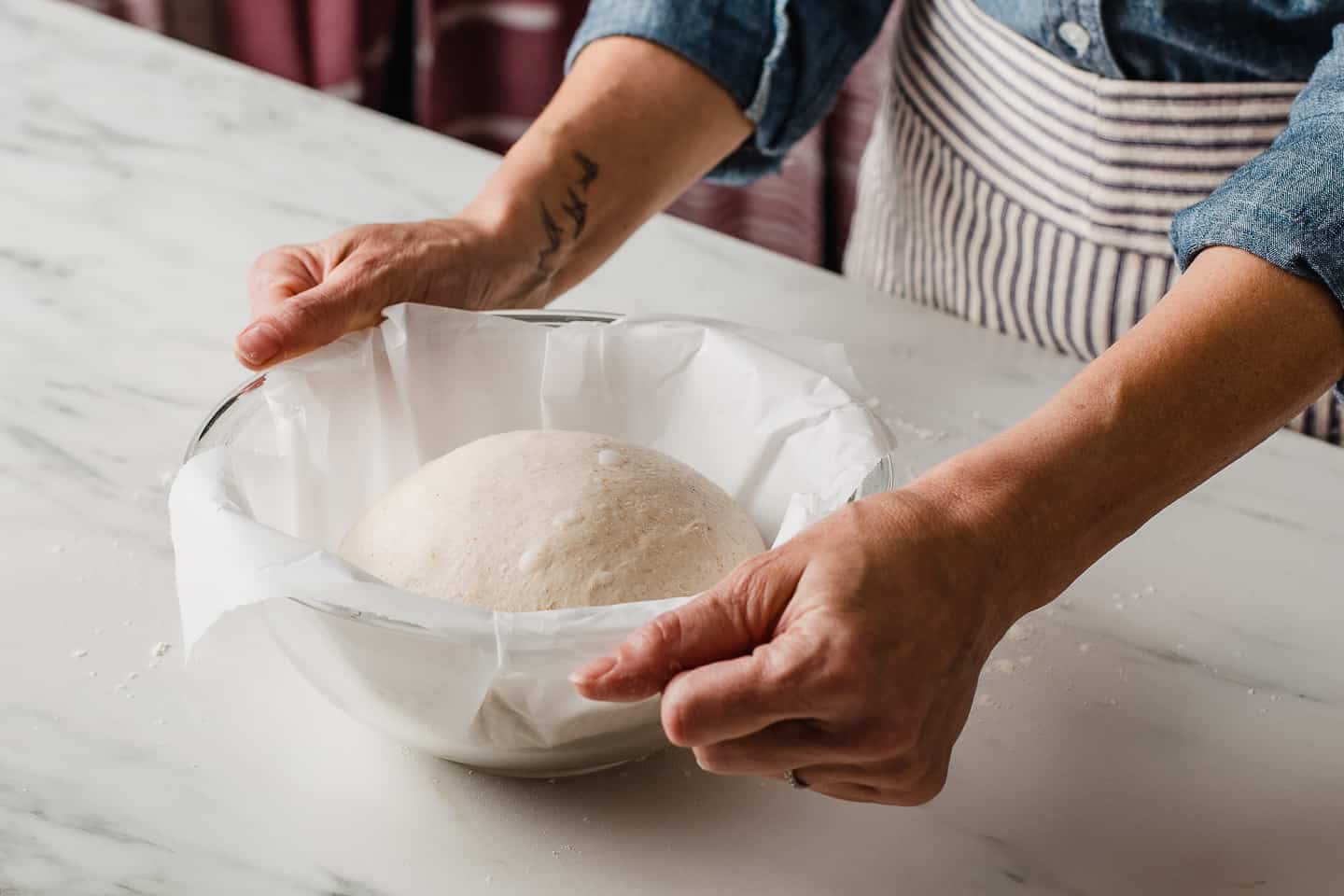
Step six: score and bake
30 minutes before you're ready to bake, preheat your oven to 450°F (232°C), with the empty dutch oven inside. Right before baking, use a sharp razor to score the top of the dough. Use silicon gloves to remove the dutch oven from the oven and take off the lid. Using the parchment paper as a sling, carefully transfer the dough to the dutch oven.
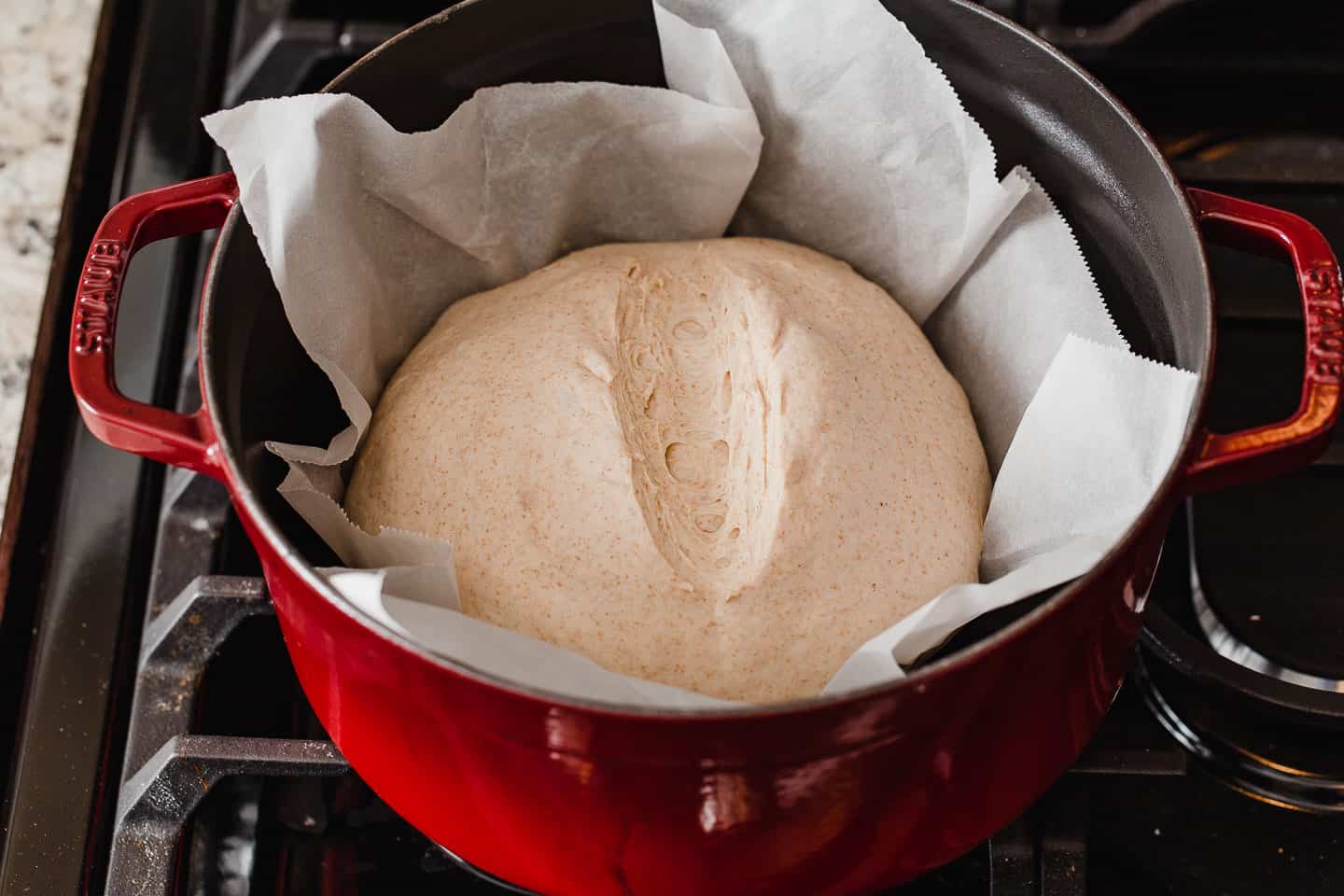
Cover with the lid and bake for 20 minutes. Remove the lid and bake uncovered for an additional 25-30 minutes or until crust is golden brown. A more accurate way to check that the bread has finished baking is to take the internal temperature with a digital food thermometer. It should register somewhere in the range of 205-210°F (96-99°C) when it is done.
Let the bread cool on a cooling for 1-2 hours before slicing to prevent it from becoming gummy.
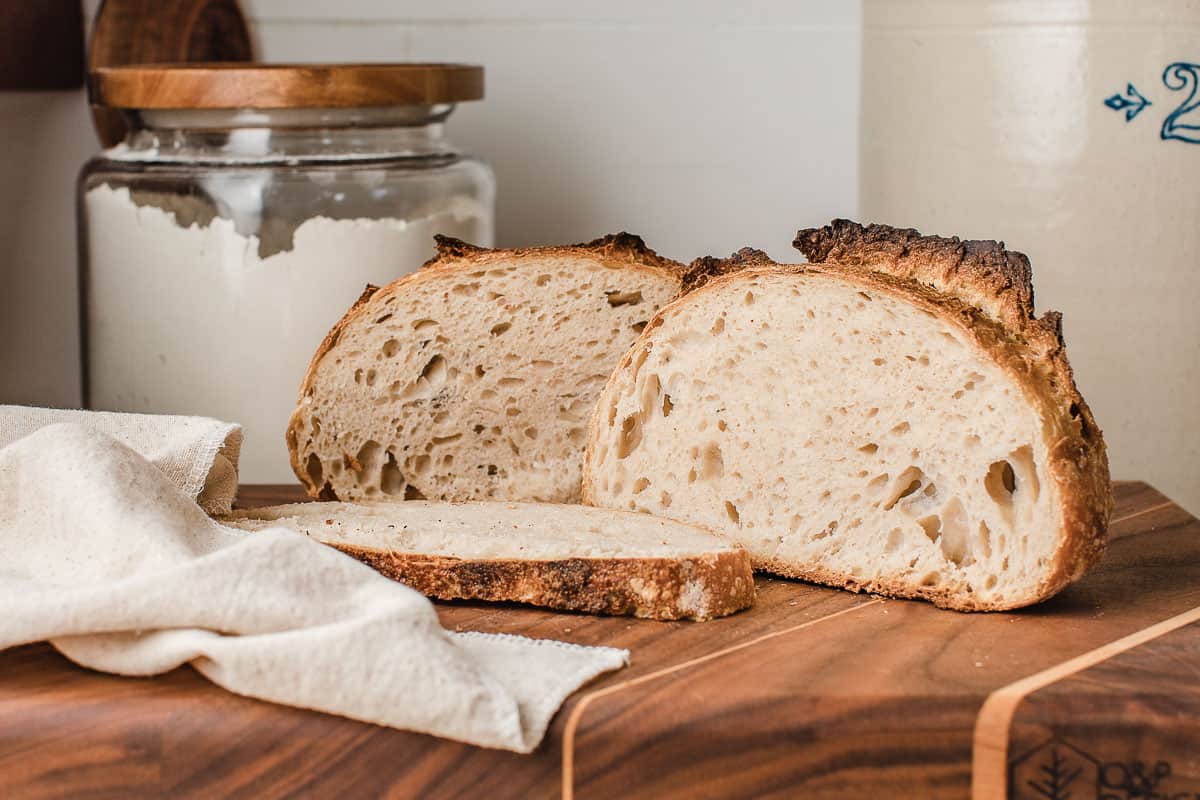
Sample baking schedule
The following are my morning and evening baking schedules. Take a look at them so that you can easily adjust them to fit your schedule. Keep in mind that in colder months, the rising times will need to be longer and in warmer months, you may need to shorten them. For these examples, my kitchen is 68°F (20°C).
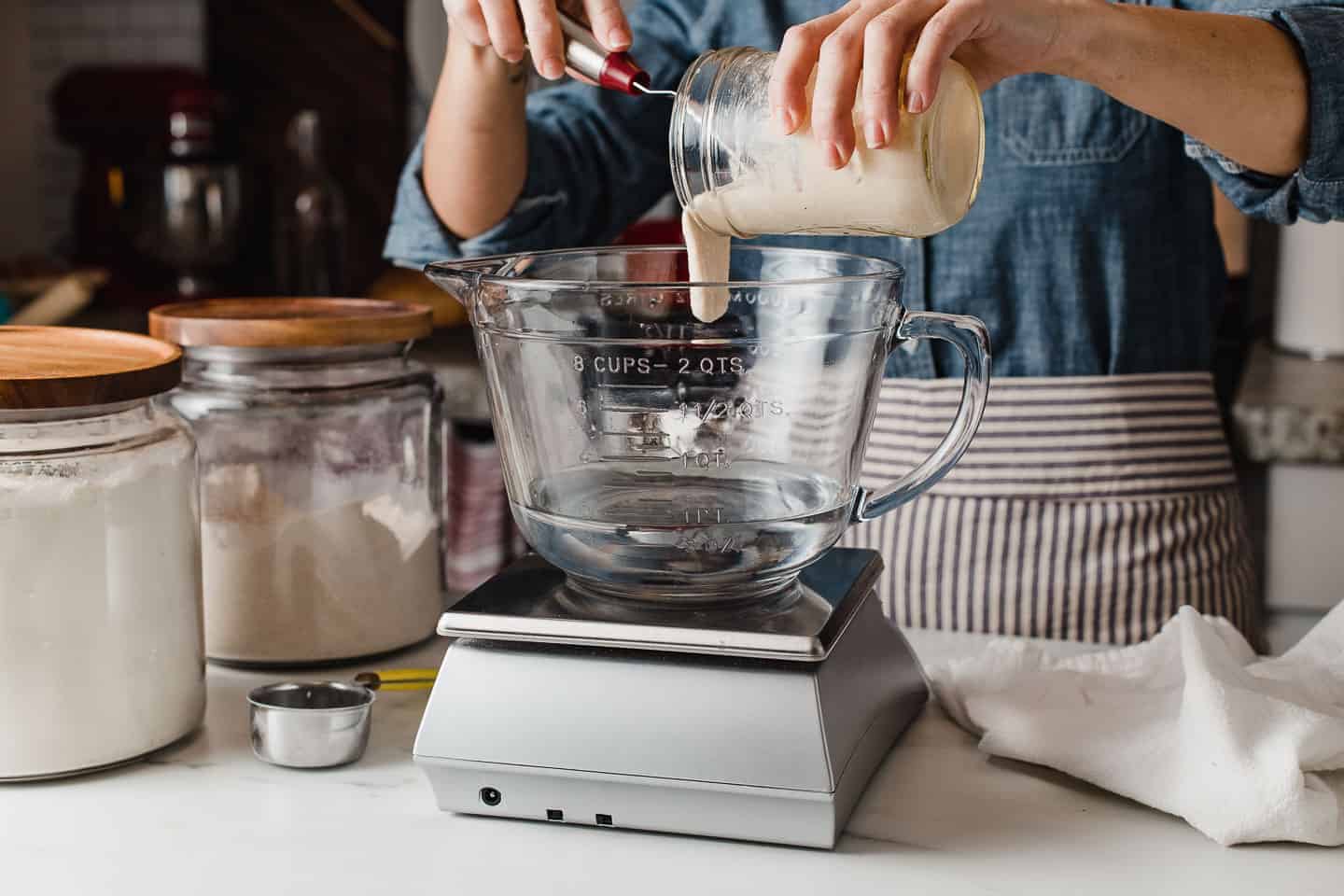
To bake bread in the morning
- 8:00 am: Feed the sourdough starter in the morning the day BEFORE you wish to bake.
- 8:00 pm: That evening mix the dough and let it rest at room temperature for 1 hour.
- 9:00 pm: Stretch and fold the dough, cover and let it rest at room temperature for 30 minutes.
- 9:30 pm: Perform a second set of stretches and folds. Cover the bowl and let it rest on the kitchen counter overnight.
- 6:00 am: Shape the dough, place it onto a piece of parchment paper and then into a proofing bowl. Cover the bowl and let it rise for 1 hour.
- 6:30 am: While the dough is still rising, place your dutch oven into the oven and preheat at 450°F (232°C) for 30 minutes.
- 7:00 am: Bake covered for 20 minutes, uncover and bake an additional 25-30 minutes.
To bake bread in the evening
- 6:00 pm: Feed the sourdough starter the evening BEFORE you wish to bake.
- 6:00 am: The following morning mix dough and let it rest at room temperature for 1 hour.
- 7:00 am: Stretch and fold the dough, cover and let it rest at room temperature for 30 minutes.
- 7:30 am: Perform a second set of stretches and folds. Cover the bowl and let it rest on the kitchen counter.
- 4:00 pm: Shape the dough, place it onto a piece of parchment paper and then into a proofing bowl. Cover the bowl and let it rise for 1 hour.
- 4:30 pm: While the dough is still rising, place your dutch oven into the oven and preheat at 450°F (232°C) for 30 minutes.
- 5:00 pm: Bake covered for 20 minutes, uncover and bake an additional 25-30 minutes.
How to store and freeze
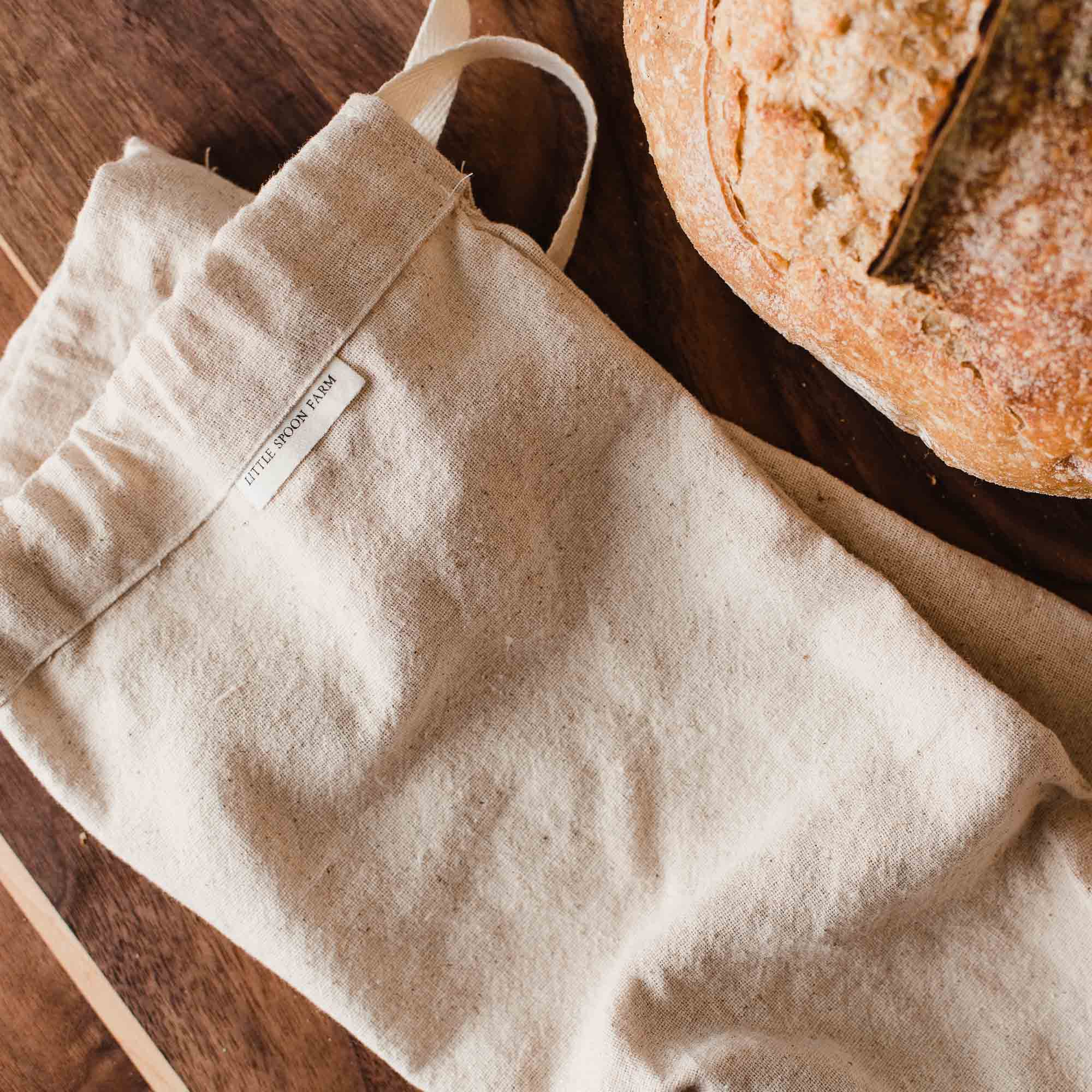
Store the bread at room temperature, in a bread bag, wrapped in a kitchen towel or beeswax wrap. You can also store the bread, sliced-side down, on a cutting board with a cake-stand top covering the bread. Do not refrigerate.
Freeze full loaves or individual slices wrapped tightly in plastic wrap and inserted into a freezer-safe container for up to 3 months.
Tips for success
- Keep a baking journal! Write down information such as the temperature of your kitchen and what rising times you use. In warm seasons, the bread will rise faster than in cooler seasons. This information will help you to make adjustments for better results each time you bake!
- Use sourdough starter that has been fed and is active and bubbly. Feed the starter and use it when it has risen to its peak in the jar.
- We use bread flour when making sourdough bread because it has a high protein content. Higher protein creates better gluten development, which in turn, produces a higher rise. All-purpose flour can be used for this recipe with modifications. Reduce the amount of water by 25 grams in the initial mix. This is because all-purpose flour absorbs less water than bread flour. If the dough feels too stiff after it's rested for the first hour, work in the reserved 25 grams of water, 5 grams at a time, until it feels right. If you end up adding too much water, work a light dusting of flour it into the dough until it comes together.
- If you don't have a kitchen scale use the scoop and level technique to measure your flour. To do this, use a spoon to fluff up the flour in the bag. Use a spoon to scoop the flour into a measuring cup until it is heaped on top. Take a butterknife and level off the top. This should give you the most accurate measurement for flour.
- Don't have a dutch oven? No problem! You can bake this bread in a lightly greased 9" x 5" loaf pan. After the first rise, shape the dough, place it seam-side down into the loaf pan and allow it to rise. Bake the loaf in a 375°F (190°C) oven for 45 minutes or until the internal temperature is 190°F (88°C).
Common questions
How can I tell if sourdough is over or under-proofed?
Over-proofed: After the bulk rise, if the dough is super sticky and/or hard to shape it is probably over-proofed. Sourdough can easily overproof in warm and/or humid climates, so a warm kitchen is the most likely culprit. Take note of the temperature of your kitchen and reduce the rising time on your next bake accordingly.
Under-proofed dough: Use your thumb to make an indentation in the dough about a ½ inch deep. If the indentation quickly springs back all the way, or almost all the way, it's still under-proofed. When the indention takes time to spring back, you'll know it's ready to bake. (If it doesn't spring back at all, it's over-proofed.) If the bread is gummy after it's baked, it was most likely under-proofed.
Why is my sourdough bread so sour?
If your starter is not fed regularly, it can take on a more sour flavor. This is because of a build of lactic acid in the starter. To get a less sour flavor, make sure to feed your starter more frequently before you bake. This may require that you feed it for 2 days before you plan to bake in order to "balance out" and reduce the amount of lactic acid it contains.
Why is my dough not rising?
Is your kitchen cold, less than 65°F (18°C)? In cooler months, it can take much longer for sourdough bread to rise than in warmer months. You can either let the dough rise longer and/or increase the amount of starter in the dough by 25-50 grams in your next bake.
My sourdough bottom crust is too hard and thick
A hard crust on the bottom of the loaf can be caused by the dutch oven being too hot on the bottom. To remedy this, place a pizza stone or baking sheet on the oven rack that is one level below the rack that the dutch oven is resting on. (NOT on the same rack.) This will create a warm barrier between the dutch oven and the heating element of the oven which will help keep the bottom of the dutch oven from getting too hot.
An overall hard crust can be caused by a high oven temperature or over-baking. Increase the covered baking time to 30 minutes and decrease the uncovered baking time to 20 minutes. This will help trap more moisture and produce a softer crust. If you bake often it's a good idea to use an oven thermometer once in a while to check the accuracy of your oven's temperature.
Recommended equipment
Here is a list of my "must-haves" and a few "good-to-have" pieces of equipment when it comes to sourdough baking.
- kitchen scale (affiliate link) If you want to bake sourdough bread, a kitchen scale is highly recommended. You will achieve much better results by weighing the ingredients.
- dutch oven with lid (affiliate link) A 4-6 quart cast iron dutch oven acts like a commercial steam oven by trapping the steam from the dough during the first 20 minutes of baking. This steam helps to produce a good "oven spring" or rise to the bread.
- long silicone gloves (affiliate link) These are a "must-have" if you bake sourdough bread frequently. The long silicone gloves will protect your hands as well as your forearms from being burnt. A cast iron dutch oven is very heavy so a good quality silicone glove is highly recommended for safety!
- parchment paper (affiliate link) Use a good quality parchment paper. It can be used more than once as long as it doesn't rip when you remove the bread from the dutch oven. Members Mark brand is my personal favorite.
- bench scraper (affiliate link) This is an essential tool in my opinion. Use it to easily divide and shape the dough, and clean flour from your work surface!
- bread lame with razor (affiliate link) The lame holds a double-sided razor while you score the dough, which protects your fingers. You can also use a very sharp knife or scissors to score the dough.
- 10" oval bread banneton and/or 10" round bread banneton (affiliate links) Bannetons are proofing baskets which provide structure to the dough as it rises. They are used when cold proofing dough like our sourdough country loaf bread during the second rise. Any similar sized bowl lined with a kitchen tea towel will achieve the same goal.
- digital food thermometer (affiliate link) Use this tool to measure the internal temperature of the baked bread or dough.
- fridge/freezer thermometer (affiliate link) It is crucial to take into account the temperature of your kitchen as it is the variable that will affect the rising times more than anything else! I use this fridge thermometer to monitor the temperature of my kitchen and make adjustments to my baking schedule accordingly.
More easy sourdough bread recipes
We only share the easiest sourdough recipes and always include step-by-step instructions to make it as simple as possible. Here are a few other recipes to try!
- soft sourdough dinner rolls
- honey wheat sourdough sandwich bread
- sourdough country loaf bread
- jalapeno cheddar sourdough bread

-
Kitchen Scale
-
Spatula
-
Mixing Bowls
-
Kitchen Towels/Plastic wrap to cover bowl
-
Bench-Scraper
-
Sharp Razor for scoring
-
Parchment Paper
-
5 quart Dutch Oven
Ingredients to make ¼ cup (50 g) of Active Sourdough Starter
- 2 teaspoons (10 g) sourdough starter
- 3 tablespoons (25 g) all-purpose flour
- 5 teaspoons (25 g) water
Dough Ingredients
- ¼ cup (50 g) active sourdough starter (100% hydration)
- 1 ⅓ cups + 2 tablespoons (350 g) water
- 2 teaspoons (10 g) fine sea salt
- 4 cups + 2 tablespoons (500 g) bread flour
Feed your Sourdough Starter
-
12 hours before you plan to mix the dough, add the ingredients to make ¼ cup (50 g) of active sourdough starter to a clean jar. Stir until combined, loosely cover the jar and let the starter rise at room temperature. (The ingredients will create a total of 60 g active starter but some of it will stick to the sides of the jar during the transfer, so we are making a little more than needed.)The sourdough starter is ready to use when it has doubled in size and there are plenty of bubbles on the surface and sides of the jar.
Make the Dough
-
Mix the dough:Transfer 50 g of the active starter and 350 g water into a large mixing bowl. Stir to distribute the starter evenly. Add 500 g bread flour and 10 g sea salt to the bowl and use a stiff spatula or your hands to work the ingredients together until it forms a shaggy mass and there are no dry bits of flour left in the bowl. Cover the bowl and let the dough rest for one hour at room temperature.
-
Stretch and Fold:Wet your hand with a little water to prevent sticking. Pick up the dough on one side and stretch it up and over itself. Turn the bowl a quarter turn and repeat this step until you have turned the bowl a full circle. The dough should form into a tight ball. Cover the bowl and let the dough rest for 30 minutes. Repeat the stretch and fold process one more time to help build volume in the final loaf.
-
Bulk Fermentation: Cover the bowl and let the dough rise for 7-10 hours on your kitchen counter. The dough will have risen by about 50%, not doubled, when it is ready to shape. (If the dough has doubled in size and/or is hard to shape, it may be over-proofed. Reduce the rising time on your next bake.)
-
Shape and Second Rise:Turn the dough out onto a lightly floured surface. Shape the dough into a ball by pulling 4 sides of the dough into the middle of itself. Turn the dough over so that it is seam-side down. Use your hands to gently cup the dough, pulling and twisting towards yourself until it forms a tight skin on the outside. Center the dough onto a piece of parchment paper, seam-side down. Use the parchment paper like a sling to lift the dough up and transfer it into a medium-sized bowl. Cover the bowl with a tea towel and let the dough rest at room temperature for 30-60 minutes.
-
Score and Bake:30 minutes before you're ready to bake, preheat the oven, with the dutch oven inside, to 450°F (232°C). Using long silicone gloves, carefully remove the hot dutch oven and take the lid off. Score the top of the dough with a razor or a sharp knife. Once again, use the parchment paper as a sling to lift the dough up and transfer it into the dutch oven. Place the lid on the dutch oven, return it to the oven and bake for 20 minutes. Remove the lid and bake an additional 25-30 minutes or until crust is golden brown. The internal temperature of the bread should be around 205-210°F (96-99°C) using a digital food thermometer.
-
Cool: Transfer the baked bread to a cooling rack for 1-2 hours before slicing. The bread will continue to cook inside during this time. If you slice into it too soon, it will result in a gummy loaf.
-
Store: Keep the bread at room temperature, in a bread bag, wrapped in a kitchen towel or beeswax wrap. You can also store the bread, sliced-side down, on a cutting board with a cake-stand top covering the bread. Do not refrigerate. Freeze full loaves or individual slices wrapped tightly in plastic wrap and inserted into a freezer-safe container for up to 3 months.
-
Serve: Nothing beats the taste of warm sourdough bread slathered with homemade butter, unless it's homemade Nutella or strawberry jam!
- This recipe was tested in a 68°F (20°C) kitchen. If your kitchen is colder, rising times will take longer and if it's warmer, less time.
- If you don't have a kitchen scale use the scoop and level technique to measure your flour. To do this, use a spoon to fluff up the flour in the bag. Use a spoon to scoop the flour into a measuring cup until it is heaped on top. Take a butterknife and level off the top. This should give you the most accurate measurement for flour.
- All-purpose flour can be used for this recipe with modifications. Reduce the amount of water by 25 grams in the initial mix. This is because all-purpose flour absorbs less water than bread flour. If the dough feels too stiff after it's rested for the first hour, work in the reserved 25 grams of water, 5 grams at a time, until it feels right. If you end up adding too much water, work a light dusting of flour it into the dough until it comes together.
- Don't have a dutch oven? No problem! You can bake this bread in a lightly greased 9" x 5" loaf pan. After the first rise, shape the dough, place it seam-side down into the loaf pan and allow it to rise. Bake the loaf in a 375°F (190°C) oven for 45 minutes or until the internal temperature is 190°F (88°C).
Calories per serving: 154
How to Make Sourdough Bread From a Starter
Source: https://littlespoonfarm.com/sourdough-bread-recipe-beginners-guide/